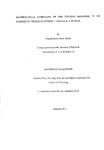MATHEMATICAL MODELLING OF THE DYNAMIC RESPONSE, IN SIX DEGREES OF FREEDOM, OF SMALL VESSELS IN A SEAWAY
| dc.contributor.author | Wallis, Barbara Diana | |
| dc.contributor.other | Faculty of Science and Engineering | en_US |
| dc.date.accessioned | 2013-09-16T08:54:20Z | |
| dc.date.available | 2013-09-16T08:54:20Z | |
| dc.date.issued | 1997 | |
| dc.identifier | NOT AVAILABLE | en_US |
| dc.identifier.uri | http://hdl.handle.net/10026.1/1725 | |
| dc.description.abstract |
This thesis treats the motion of a small vessel described in six degrees of freedom. There are three are translation equations of motion and the other three are equations of angular motion. The aim is to develop a model with a sound mathematical base and use experimentation to find forces to aid the completion of the model, with the intention of use in an auto pilot, by the following means: 1) By solving the equations of motion for large movements, with given sea and wind conditions and also with given control forces and moments. 2) Deduce the forces and moments being applied from the sea etc., from the motion of the vessel. Thus to enable the auto pilot to deduce the required additional forces and the forces and moments applied by the water and wind and the control devices, such as the propeller and rudder. These two aims are achieved by analysing the transformation of axes using the standard Euler equations. However, as Euler's angles are ordered and therefore cannot cope with large angles which are present in the motion of a small vessel, another set of angles relating to axes and planes have been deduced. These are then rotated and the set of three measured angles are found in terms of the Euler angles. This is the main pan of original work in the thesis. The rest of the thesis is then based upon these set of measured angles and a general case mathematical model is deduced using them. This is proceeded by a functional analysis of the vessel's motion, environment and control action's. After that the general case model is theoretically validated by analysing the work done by ARJM Lloyd and showing how his work is a specific case of the general case. Experimental work performed on a small vessel is then used in the building of a mathematical model for the specific case of a small vessel, using a set of measured angles. | en_US |
| dc.description.sponsorship | Marinex Industries, Poole | en_US |
| dc.language.iso | en | en_US |
| dc.publisher | University of Plymouth | en_US |
| dc.title | MATHEMATICAL MODELLING OF THE DYNAMIC RESPONSE, IN SIX DEGREES OF FREEDOM, OF SMALL VESSELS IN A SEAWAY | en_US |
| dc.type | Thesis | |
| plymouth.version | Full version | en_US |
| dc.identifier.doi | http://dx.doi.org/10.24382/3980 |
Files in this item
This item appears in the following Collection(s)
-
01 Research Theses Main Collection
Research Theses Main


